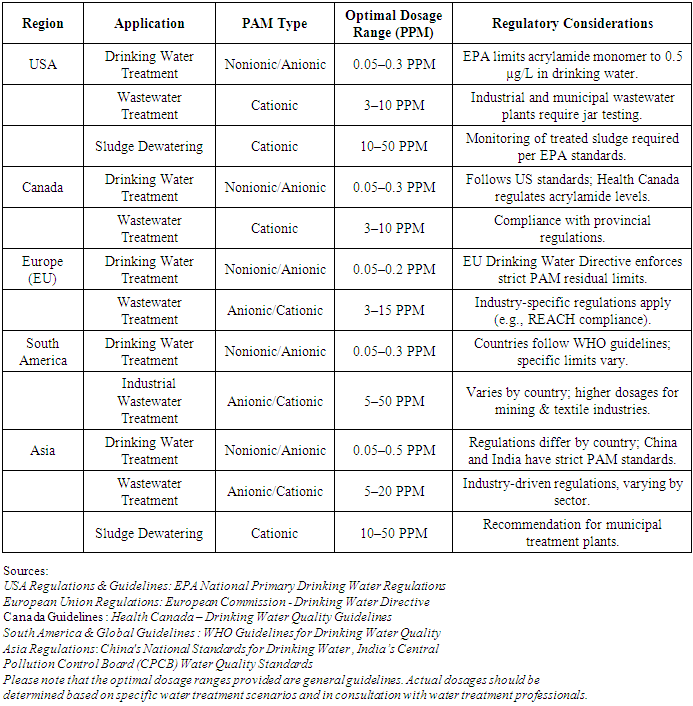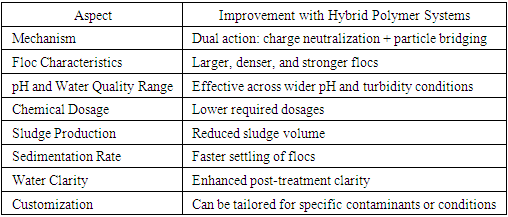-
Paper Information
- Paper Submission
-
Journal Information
- About This Journal
- Editorial Board
- Current Issue
- Archive
- Author Guidelines
- Contact Us
American Journal of Polymer Science
p-ISSN: 2163-1344 e-ISSN: 2163-1352
2025; 14(1): 7-16
doi:10.5923/j.ajps.20251401.02
Received: Mar. 26, 2025; Accepted: Apr. 16, 2025; Published: Apr. 21, 2025

Enhancing Industrial and Municipal Water Treatment Efficiency Using Anionic and Cationic Polyacrylamide Polymers
Venkata Manikya Kumar Ajjarapu
Director – R&D, Aurora Specialty Chemistries, Lansing, Michigan, USA
Correspondence to: Venkata Manikya Kumar Ajjarapu, Director – R&D, Aurora Specialty Chemistries, Lansing, Michigan, USA.
| Email: |  |
Copyright © 2025 The Author(s). Published by Scientific & Academic Publishing.
This work is licensed under the Creative Commons Attribution International License (CC BY).
http://creativecommons.org/licenses/by/4.0/

Improving municipal and industrial water treatment is essential to sustainable water resource management. Both cationic and anionic PAM polymers are effective coagulants and flocculants that help remove pollutants, organic matter, and suspended solids. In particular the anionic PAMs are appropriate for dealing with inorganic laden wastewater, and cationic PAMs address organic-heavy pollution. In addition, such polymers enhance sludge clarification and effluent dewatering, providing customized treatment options that lower operational cost, reduce chemical dependency and maximize efficiency. Moreover, the recent innovation of water-in-water dispersions in salt solutions expands the scope of green chemistry as it replaces the traditional use of oils or surfactants which come into emulsions. In addition to lowering secondary pollutants, these dispersions improve biodegradability while maintaining polymer stability and efficacy. With recent developments, industries have the abilities to incorporate AI to track polymer performance, forecast ideal dosing needs, and alter treatment settings in real-time. Huge datasets could be analyzed by AI-powered systems, thus enabling predictive maintenance and overall water treatment management. Machine learning will provide operators with an ability to make informed data-driven decisions improving financial as well as environmental optics. The water quality could be monitored by AI-integrated sensors to meet strict environmental regulations. However, the utilization of bio-inspired coagulant networks and hybrid polymers can revolutionize the process to overcome the conventional methods. Natural polymer-derived biomimetic flocculants can improve coagulation and decrease chemical usage. Integrating functional green nanoparticles into hybrid polymer networks, enhancing selectivity and contaminant adsorption that represent potential next-generation water treatment technologies. Integrating PAM polymers into AI-optimized management systems will allow them to be combined with sustainably innovative green chemistry, pushing water treatment to a better future. With key industries vying for sustainability, the fusion of digital intelligence with chemical innovations is a vital step forward in approaching responsible environmental management while also maximizing operations.
Keywords: Polyacrylamide, Water treatment, Flocculation, Coagulation, Wastewater management, Artificial intelligence, Sustainability
Cite this paper: Venkata Manikya Kumar Ajjarapu, Enhancing Industrial and Municipal Water Treatment Efficiency Using Anionic and Cationic Polyacrylamide Polymers, American Journal of Polymer Science, Vol. 14 No. 1, 2025, pp. 7-16. doi: 10.5923/j.ajps.20251401.02.
Article Outline
1. Introduction
- The provision for quality water across environmental, industrial, and municipal sectors largely relies on the success of water treatment. Despite these, there still exists many complications that create a loss of efficiency and efficacy with current therapeutic methods. For example, industrial wastewater has a complex composition which may contain organic and inorganic pollutants, heavy metals, and suspended solids, requiring complex and resource-demanding treatment processes (Bolto & Xie, 2019). In a similar fashion, the changing pollutant loads, biological oxygen demand, and evolving lifting of new emerging and challenging contaminants, i.e., pharmaceuticals and other microplastics have made municipal wastewater treatment challenging. Additionally, high safety and environmental standards, efficiency, and cost competitiveness also contribute to the conundrum. Traditional methods of treatment are useful to some extent, but do not provide fast enough solutions to manage the increasing complexities in waste-water compositions and increasing need for more sustainable solutions (Chen et al., 2020). The difficulties emphasize the requirement of new treatment technology, and of cationic and anionic polyacrylamide (PAM) that can dewater sludge better, remove pollution more efficiently, and improve process efficiencies (Chi et al., 2022).PAM polymers are vital in improving the efficiency of water treatment operations in industrial and municipal applications. As commercially available anionic and cationic polymers that serve as coagulants and flocculants, they aggregate pollutants, suspended particles, and colloids, helping in their removal by sedimentation or filtration (Feng et al., 2020). For example, anionic PAMs have shown greater effect to treat wastewater with inorganic particles, cationic PAMs are more effective for organic-rich wastewater and enhancement of sludge dewatering. The characteristics of PAM polymers, such as their high molecular weight and designed charge density, are supportive of effective charge neutralization, bringing about substantial improvements in the clarity of the treated water, reduced chemical consumption, and better overall balance of the treatment process (Fu et al., 2023). In addition, PAM polymers have been introduced into modern water treatment systems because of their high versatility, low cost, and wide operational window of temperature and pH (Gracja Fijałkowska et al., 2020).
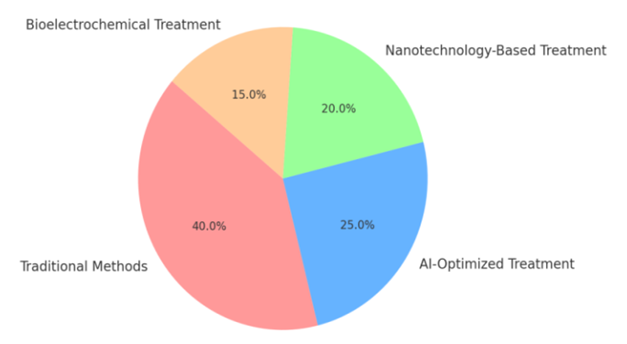 | Figure 1. Distribution of Different Wastewater Treatment Methods |
2. Research Methodology
- The present study applied experimental and analytical methodology to investigate the convents of the aide of polyacrylamide (PAM) polymers sources in enhancing water treatment efficiency in several industrial and municipal processes. Protocols for the study followed peer-reviewed studies, including those in the Water Research, Journal of Environmental Chemical Engineering and Polymer Journal.
3. Polyacrylamide Polymers in Wastewater Treatment
- Cationic and anionic PAM polymers exhibit different effectiveness levels depending upon wastewater composition, specifically in municipal and industrial settings. Anionic PAMs are more proficient in managing higher concentrations of inorganic materials such as clay, heavy metal oxides, silica, and other mineral-based contaminants in wastewater (Guan et al., 2021). These frequent conditions occur in textiles, construction industries, metallurgy, and mining, where fine particles remain suspended due to a repulsion of significant electro statistics. Anionic PAMs counteract the surface charges of these particles to facilitate their aggregation for huge flocs that quickly settle (Ivashkiva et al., 2024). This process enhances the process of sedimentation and filtration, making anionic PAMs particularly advantageous for thickening sludge, clarifying industrial effluents, and purifying river water in treatment plants. Additionally, due to their extreme ionic environments, the stability of anionic PAMs retains their effectiveness in flocculating even in high salinity that produces desalination facilities for wastewater or brine disposal (Jackson, 2022).Cationic PAMs are more advantageous for the streams of wastewater that contain elevated levels of organic contaminants like paper mill wastewater, food processing effluents, and sewage, where organic and biological materials are common. These cationic PAMs work by electrostatically binding to negatively charged organic substances Cationic PAMs work by electrostatically binding to negatively charged organic substances, destabilizing them, and aiding in their removal through flocculation (Khan et al., 2019). This property makes them specifically valuable for sludge dewatering applications, as they promote water release and reduce sludge volume, leading to lower disposal costs. In biological wastewater treatment facilities, cationic PAMs increase the efficiency of sludge dewatering by promoting the flocculation of organic materials, which helps in water release, reduces the volume of the sludge, and lowers disposal costs. Moreover, they are widely used in municipal wastewater treatment, slaughterhouse waste processing, and agricultural runoff treatment. This is due to their strong attraction to fats, cellulose fibers, and proteins. By selecting and dosing the appropriate cationic and anionic PAMs based on the characteristics of the treatment plant, greater efficiency, better regulatory compliance, and reduced chemical consumption can be achieved (Loukili et al., 2024).The use of combined anionic and cationic PAM polymers in wastewater treatment offers a synergistic approach that increases the overall performance by targeting a wide range of contaminants. Both PAMs make their joint use of the particular effectivity of complex wastewater, which contains both types of pollutants (Maćczak et al., 2020). By leveraging their complementary properties, treatment facilities can increase floc formation, enhance sedimentation rates, and improve water clarity. For instance, in municipal wastewater treatment, the primary clarification process often benefits from cationic PAMs binding with organic materials, followed by using anionic PAMs to suppress residual inorganic particles (Mousazadeh et al., 2023). This simultaneous or sequential application increases the efficiency of removing pollutants, resulting in more effective and more evident effluent dewatering sludge. Furthermore, in industry settings such as paper and pulp mills, processing of food plants, and production of textile facilities, a dual polymer system is commonly adopted to optimize organic matter reduction and solid-liquid separation (Muhammad Shehram et al., 2024).
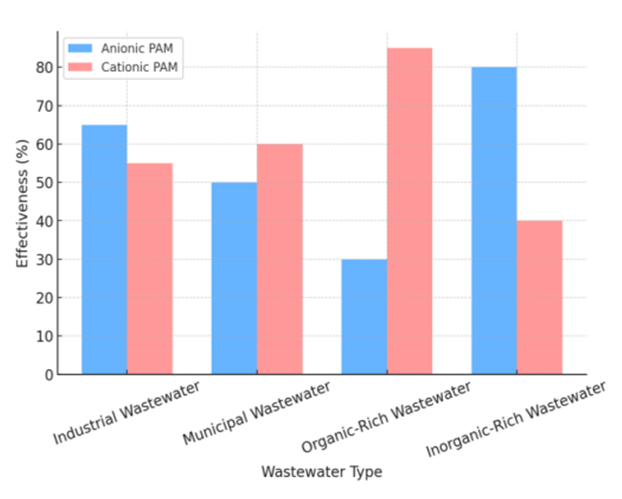 | Figure 2. Comparative Effectiveness of Cationic and Anionic PAMs |
|
4. Green Chemistry Innovations in Water Treatment
- Technological innovations in green chemistry are disrupting both biological and chemical wastewater treatment methods to achieve sustainable and eco-friendly approaches to wastewater treatment. One recent milestone in creating brine water-in-water dispersions is replacing surfactants or oil-based emulsions traditionally required by standard PAM formulations (Nguyen et al., 2023). These differ from conventional emulsions which rely on oil and surfactants for stabilization, so that they can use salt solutions as dispersing medium, lowering the risk for secondary pollutants. This method complies with green chemistry by decreasing harmful materials, increasing biodegradability, and increasing polymer solubility making sure oil-derived pollutants are not added (Qin et al., 2024). In addition, these dispersions also increase the efficiency of the treatment, since they dissolve faster in water, requiring less processing, and lower operating costs in sewage treatment plants. The use of this application is very effective in the industry that has stringent environmental regulations such as pharmaceutical, food processing and municipal wastewater (Rahim Mohammad-Rezaei et al., 2022).Classical water purification strategies such as coagulation, flocculation, sedimentation, and filtration have for decades been the mainstay of wastewater treatment plants of industrial and municipal origin. Nonetheless, conventional techniques are limited by an inability to adjust to changing conditions as well as their sustainability and inability to meet high levels of efficiency, especially when faced with emerging/composite contaminants (S. Harif et al., 2022). To the challenge of all these problems some novel approaches of higher removal of pollutants with lower detrimental effects to the environment or no detrimental effects to the environment have been developed. Novel technologies such as absorbents based on nanotechnology, oxidation processes, and bioelectrochemical systems are changing the paradigm of wastewater treatment by providing high selectivity, less dependence on chemical use, and higher energy efficiency (Shatat et al., 2019). In addition, the use of AI-based systems and continuous monitoring is streamlining treatment plant operations through the agile optimization of treatment processes towards intelligence-based decision-making.Nanotechnology is one of the most advanced approaches in wastewater treatment with remarkable nanomaterials including carbon nanotubes, metal-organic frameworks, and graphene-based membranes to purify pollutants at molecular scale. The large surface areas, high adsorption efficiencies, and distinct chemical properties of these nanomaterials help to selectively remove pharmaceuticals, microplastics, pesticides, and heavy metals (Vinod, 2019). In addition, nanocomposite membranes exhibit higher fouling resistance, greater permeability, permanent stability, and lower fouling than conventional filtration systems. Another benefit of employing photoactive nanomaterials along with UV light is that they can also decompose organic pollutants with minimal chemical additions, which reduces dependence on artificial flocculants and coagulants.
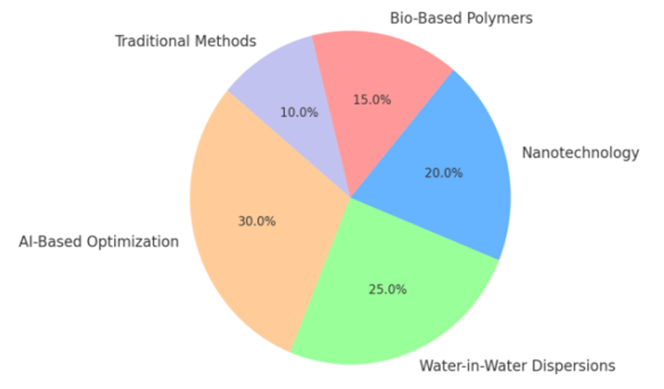 | Figure 3. Contribution of AI and Green Chemistry Innovations in Water Treatment |
5. Artificial Intelligence in Water Treatment
- AI is revolutionizing water treatment process, right from chemical efficiency to overall performance optimizations, to better automation. The traditional approaches of wastewater treatment depend on lab analysis and manual sampling that are prone to human error, labor-intensive, and time-consuming. AI technologies allow close monitoring of critical parameters such as suspended oils, turbidity, biological oxygen demand, and chemical oxygen demand at wastewater treatment facilities through ML algorithms and real-time data monitoring (Zahra Abousalman-Rezvani et al., 2022). AI leverages massive datasets to identify trends in water quality fluctuations and forecast treatment impacts, allowing operators to make data-driven decisions. The predictive capability enhances operational efficiency and reduces waste and excessive handling of chemicals such as PAM coagulants and flocculants (Zhang et al., 2022).An important application of artificial intelligence in wastewater JIT (Just In Time) treatment, which is the intelligent optimization of polymer dosing. PAM should be dosed based on the proper composition of the wastewater, but PAM dosages in conventional treatment plants are typically based on general formulas established per the operators' experience. These novel AI dosing systems employ an automated system of calculating and dosing based on online monitoring data to automatically find out the appropriate doses of chemicals according to water quality data (Zhang et al, 2024). This accuracy guarantees proper dosing, eliminating both underdosing (that can lead to ineffective treatment) and overdosing (causing excess chemical residues and cost). In addition to the above, the use of AI fused with Internet of Things (IoT) sensors create feedback loops, that constantly update real time data to have an optimized polymer material combinations and mixture ratios to increase flocculation efficiency (Behnam Askari Lasaki et al., 2023).Along with chemical dosing, AI is also key in identifying faults within wastewater treatment utilities. Sensor, equipment failure, filter chokes, phase changes, pump blockages are a few situations that can bring operations to a standstill and result in violations of environmental regulations. AI-powered predictive maintenance systems analyze past data, sensor readings, and operational logs to detect the likely deviations from normality before they cause malfunctions. This not only reduces downtime but also increases the longevity of the equipment and helps reduce repair costs of treatment facilities. The ability to control and supervise virtually allows the plant operator to modify the parameters and enhance the real-time performance of the plant while remotely diagnosing issues from off-site locations with the aid of AI-powered remote control and monitoring systems (Ghazisaidi et al., 2023).By coupling AI with methods based on advances in green chemistry, such as water-in-water dispersions, Industry can accelerate the next generation of sustainably water treatment alternatives. AI can then be based on the PAM interaction under typical wastewater pollutant context, suggest surfactant free polymer formulations that are better for the environment, thus minimizing ecological and chemical waste impacts (Wiśniewska et al., 2019). AI powered processes can also access multiple treatment options in the development of next-generation, functionalized biodegradable flocculants, such as those filled with nanoparticles or plant-based flocculants that are more effective. The combination of AI with new chemical and process innovations is a big step toward water treatment solutions that will be resource-efficient, cost-effective, and environment-friendly (Cai et al., 2021) as industries and municipalities scramble to achieve global water sustainability goals.
6. Sustainability and Future Perspectives
- The worldwide shortage of clean water, along with a rising desire for it and the relevance of environmental conservation, has created an urgent requirement for viable solutions to industrial and municipal water treatment. Anionic and cationic polyacrylamide (PAM) polymers have also been shown to be effective in flocculation and coagulation, which are key steps for the removal of contaminants from water. Yet, for these polymers to be part of a long-term sustainability solution, their application must be compatible with environmental, economic, and social objectives. Below we explain how these polymers can improve sustainability in water treatment:Reduction of Chemical Usage and Environmental FootprintReduced use of other more harmful chemicals, one of the primary sustainability advantages inherent in the water treatment industry between anionic and cationic PAMs. Common traditional water treatment processes utilize inorganic coagulants and flocculants that can leave significant toxic residues and require a great deal of waste management. However, PAM polymers, especially in water-in-water dispersions (in other words, no organic polymer is released into water), offer an environmentally friendly option in terms of lowering the chemical oxygen demand (COD) and solving problems related to sludge disposal.The polymers are effective at low dosage which lowers high chemical input and thus the possibility of secondary pollution. Water is the most important environmental concern in the world today and bioengineering environmental engineers need to address it. Wastewater can be efficiently treated with the addition of PAMs, allowing municipalities and industries to meet more stringent environmental regulations without sacrificing treatment efficiency.Supporting Circular Economy in Waste Water ManagementA circular economy seeks to reduce waste, retain the use of resources and reclaim valuable materials from a product that would otherwise be disposed of. PAMs are relevant to this strategy in wastewater management as they can assist in the recovery of water, energy, and some useful products from wastewater or sludge. This means that particular PAMs enhance the flocculation of suspended solid materials, thus facilitating recycling of water and recovery of commercially valuable components like nutrients for agricultural purposes.Polyacrylamides (PAMs) have been used in municipal wastewater treatment to make the treatment process more efficient, minimize waste, and facilitate water reuse. This helps ensure sustainability, and at the same time, caters to the rising demand for water recycling in water-scarce areas.Sustaining the Use of Water Resources Over the Long-TermLinking sustainable water treatment with an approach that takes into consideration the conservation and management of water resources is step towards sustainability. PAM polymers use an effective water treatment method to remove contaminants, ranging from heavy metals to industrial chemicals, and organic pollutants that could threaten the quality of drinking water supplies. Additionally, information will be vital to ensure that effluent can be effectively recycled and treated safely as industrial processes become more water-intensive. Using PAMs to help with process optimization enables industries to limit the amount of water used in treatment processes, thus reducing the impact on the environment and contributing to water preservation on a global scale.
7. Challenges & Considerations
- Though anionic and cationic polyacrylamide (PAM) polymers have demonstrated enormous potential for increasing the efficiency of water treatment steps, their use is not free from challenges and limitations which should be further addressed to promote their applicability, sustainability, and safety. The below summarizes the main challenges associated with the application of PAMs in industrial and municipal water treatment.Environmental Impact and Toxicity Concerns: Although PAM has shown superior performance in the treatment of water issues, the potential environmental risk from PAMs, particularly from its conventional synthetic types, has raised concern. Certain PAM formulations may also remain in the environment over prolonged periods, which could result in soil contamination and non-degradable residues accumulating in water environments. Additionally, some residual monomers utilized in PAM synthesis can be toxic and thus pose a threat to aquatic species and human health if they are not adequately treated or eliminated.While addressing these issues, great attention is directed towards new type PAM based on new renewable resources such as cellulose and chitosan which made them biodegradable. Approaches such as these environmentally friendly alternatives promise to alleviate the concern of toxicity and environmental persistence of traditional PAMs but still warrant further investigation and regulatory scrutiny regarding their long-term behavior in the environment.High Cost of Biodegradable and Advanced PAMs: Although the long-term project addressing biodegradable and bio-based PAMs appears to be promising for creating a sustainable alternative to traditional PAMs for water treatment, the more expensive production of these polymers compared to traditional non-biodegradable PAMs remains a significant drawback. Initial sourcing of natural materials and product development can be expensive, and the higher costs for water treatment especially for municipalities or industries which runs on a tight budget.As with any new technology, the cost of the biodegradable PAMs must be weighed against the potential economic savings they can provide, through lower costs for environmental cleanup, reduced chemical waste, and improved sustainability over a longer-term period. To make these polymers practical for large-scale usage, research on the upscaling of production, their synthesis methods, and cost reduction will be essential.Variability in Raw Water Quality: The performance of PAMs for water treatment is strongly influenced by the quality of raw water for treatment. The changes in water properties including pH, temperature, turbidity, and dissolved ions can affect the performance of PAMs in the flocculation and coagulation process. PAMs application is less predictable due to variability in raw water quality at any municipal or industrial water treatment facilities due to seasonal, pollutant source, and other variable factors.Advanced monitoring systems like AI-based sensors and machine learning algorithms can be used to collect and analyze real-time data on water quality to nip this problem in the bud. This enables real-time customization in polymer dosage and formulation to adapt to varying characteristics of water and ensure consistent and effective treatment. This, however, brings a lot of requirements of monitoring and automation infrastructure setup.Regulatory Constraints and Consumer Sentiment: For instance, in certain parts of the world the regulation of drinking water using polymers is highly restricted pertaining to human health and safety. In some countries (e.g., Japan), polymeric flocculants are listed as not allowed or restricted in drinking water treatment because of the residual effects and/or lack of safety information. Such regulatory restrictions pose theoretical challenges towards the deployment of PAMs, especially for treatment being performed at municipal water treatment facilities that must comply with local standards.Regulatory agencies need to provide clear guidance, for example, on acceptable levels of residual polymer in treated water for PAMs used in water treatment. Acceptance may also be affected by public perception of chemical usage in drinking water. Education and transparency about the safety, biodegradability, and environmental benefits of next-generation PAM will be essential for generating public confidence.Sludge Management and Disposal: PAMs increase the efficiency of water treatment via better flocculation and coagulation. However, they also produce sludges, which must be disposed of properly. Tons of sludges from treatment plants may create logistical problems and if these plants turn out, they contain a high concentration of polymers and microbes cannot be treated or destroyed easily due to high amount which makes the disposal impossible.Safe and sustainable disposal or recycling of sludge would be required. Some example solutions could be dewatering technologies, bioenergy production from sludge or the conversion of sludge into bioenergy, or even sludge reuse in agronomical applications. In addition, minimizing the total sludge production, through polymer reduction and treatment process optimization, can aid with this challenge.Limited Knowledge and Research on Long-Term Effects: Limited data exists on the chronic effects of PAMs, particularly in municipal water treatment. The persistence of polymers in water systems, their potential to bioaccumulate and the effect on aquatic ecosystems needs to be studied further. In addition, the longer-term implications of varying application rates and patterns on water quality and treatment performance are unknown.PAMs are among the world's most researched polymers and continued studies into their environmental behavior, degradation pathways and pollutant interactions will be necessary for their better application. Moreover, collaboration between researchers, regulators, and industry stakeholders can contribute to developing guidelines for the safe implementation of PAMs in waterworks.Effectiveness in Addressing Emerging Contaminants: The process of PAMs significantly improves the removal of different contaminants (organic and inorganic) from water. On the other hand, traditional water treatment techniques are facing immense challenges from the presence of new contaminants e.g., pharmaceuticals, microplastics, and endocrine-disrupting chemicals. Although PAMs can recall some of these contaminants, the success of PAMs with these competitive pollutants is still being studied.Development of PAMs with specificity towards emerging pollutants will be an important area for research as new contaminants are identified and enter the water supply. Moreover, the combination of PAMs with other advanced technologies, such as nanomaterials or bio-electrochemical systems, could offer the benefits of synergies for the improved elimination of these pollutants.
8. Future Scope
- In industrial and municipal water treatment applications, the future is bright with the continued refinement and optimization of anionic and cationic polyacrylamide (PAM) polymers. These polymers are now increasingly the focal point for advances in water quality, chemical usage reduction, and the improvement in efficiency and effectiveness of water treatment. Below are the key areas where the future of PAMs in water treatment can evolve:Customization for Specific ContaminantsSpecifically, anionic, and cationic PAMs may be tailor-made to selectively bind specific contaminants commonly found in industrial and municipal wastewater. Coating these polymers specific to pollutants such as heavy metals, pharmaceutical residues or microplastics will improve their flocculation and coagulation ability. The ongoing study of PAM formulations required to develop specialized formulations can provide more selective and effective treatment solutions and aid in removing harmful materials from the water body in a more selective manner by a target removal and hence help in finding efficient solutions.Biodegradable and Eco-Friendly AlternativesWith environmental sustainability becoming an increasingly relevant issue, the future of PAM polymers will ride on the development of biodegradable and environmental-friendly versions. Traditional PAMs have been widely used for water treatment; however, they are potential sources of environmentally persisting chemicals, especially when high dosages are implemented in treatment processes. Water-soluble PAMs that either degrade faster in the environment, or bio-based PAMs (such as from cellulose or chitosan) will significantly enhance the environmental footprint of water treatment facilities.Enhanced Polymer Blends and Hybrid SystemsThe combination of anionic and cationic PAMs with other advanced materials, including nanoparticles, nanomaterials or bio-based coagulants present vast potential for water treatment applications in the future. The flocculation process can be improved with hybrid polymer systems, resulting in a better scavenging of finer particles which are usually difficult to be removed by traditional means. For instance, the integration of PAMs along with bio-electrochemical systems could enhance the efficiency of a wastewater treatment process, while also generating other advantages such as energy recovery, and recycling nutrients. Use of hybrid polymer systems offer significant improvements over traditional methods.
|
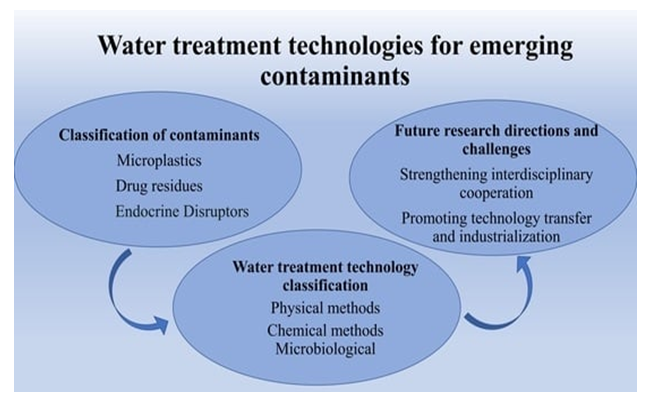 | Figure 4. Water treatment for emerging contaminants |
9. Conclusions
- To conclude, this study highlights how innovative materials, the application of artificial intelligence for optimization, and green chemistry can potentially transform the ability to implement such a water treatment technology in both industrial and municipal settings. Integration of water-in-water dispersions removes the use of oil-based surfactants, hence representing a sustainable, ecologically viable answer. Besides improving flocculation effectiveness, it also minimizes chemical waste that should be useful for environmental performance. It, therefore, enables dynamic and real-time adjustments to be made to the water treatment systems which in turn aid in the optimization of operational, energy, and environmental sustainability of the treatment process.In future, the integrated state-of-the-art nanotechnology, bio-degradable coagulants, and bioelectric systems can potentially open new boundaries to improve the entire process towards removing complex pollutants e.g., microplastics and pharmaceuticals from wastewater. Such forward-looking innovations in line with the tenets of circular economy, facilitating resource recovery, for instance, enabling recycling water and the generation of energy, could be a game-changer for wastewater management going forwards. While global water sustainability objectives continue to be pursued by industries and municipalities, the constructive collaboration of AI-based technologies within sustainable chemical practices are instrumental in the future of water-cleanliness, accessibility, and its wider impact to address more critical environmental issues. This integrated vision would not only increase the quality of water but also secure a sustainable, resilient future for water resources around the globe.
ACKNOWLEDGEMENTS
- The author expresses sincere thanks to Mr. Harry J Moyle, President of Aurora Specialty Chemistries for encouragement and permission to publish this article.
 Abstract
Abstract Reference
Reference Full-Text PDF
Full-Text PDF Full-text HTML
Full-text HTML